Varied difficulty levels in AP Inter 1st Year Zoology Model Papers and AP Inter 1st Year Zoology Question Paper May 2017 cater to students with diverse academic strengths and challenges.
AP Inter 1st Year Zoology Question Paper May 2017
Time: 3 Hours
Max. Marks: 60
Note: Read the following instructions carefully.
- Answer All the questions of Section A. Answer any SIX questions in Section B and answer any TWO questions in Section C.
- In Section A, questions from SI. Nos. 1 to 10 are of Very short answer type. Each question carries two marks. Every answer may be limited to 5 lines. Answer all questions at one place in the same order.
- In Section B, questions from Si. Nos, 11 to 18 are of Short Answer Type. Each question canles four marks. Every answer may be limited to 20 lines.
- In Section C, questions from Si. Nos. 19 to 21 are of Long answer type. Each question carries eight marks. Every answer may be limited to 60 lines.
- Draw labelled diagrams wherever necessary in Sections B and C.
Section – A
10 x 2 = 20
Note: Answer All the questions in 5 lines each.
Question 1.
What is meant by tautonymy? Give two examples.
Answer:
The practice of naming the animals or organisms, in which the generic name and species name are the same, is called Tautonymy. Ex: Axis axis – spotted dear. Naja naja – The Indian Cobra.
Question 2.
What is Cephalization? How is it useful to its possessors?
Answer:
Cephalisation: The concentration of nerve (Brain) and sensory cells at the anterior end of body is called as cephalisation. As a result of cephalisation, these animals can sense the new environment and move efficiently than the other animals in seeking food, locating matter and in avoiding from predators.
Question 3.
Distinguish between a tendon and a ligament.
Answer:
Tendons are the collagen fiber tissue of dence regular connective tissue which attach the skeletal muscles to bones. Ligaments are also the collagen fibers tissue of dence regular connective tissue which attach bones to other bones.
![]()
Question 4.
What is haematocrit value?
Answer:
The percentage of total volume occupied by RBCs in blood is called haematocrit value.
Question 5.
What is Aristotle’s Lantern? Give one example of an animal possessing it?
Answer:
In the mouth of sea Urchin a complex five-jawed masticatory apparatus called Aristotle’s Lantern. Ex: Echinus.
Question 6.
What are pneumatic bones? How do they help birds?
Answer:
Main bones in birds are extensions of air sacs without bone marrow are called pneumatic bones. These are helpful in flying to birds.
Question 7.
Distinguish between lobopodium and filopodium. Give an example to each of them.
Answer:
Lobopodium: The blunt and finger-like tubular pseudopodia containing both ectoplasm and endoplasm is called lobopodium. Ex: Amoeba proteus.
Filopodium : The slender filamentous pseudopodia with pointed tips, composed of only ectoplasm are called Filopodium. Ex: Euglypha.
Question 8.
What are dynein armes? What is their significance?
Answer:
‘A’ tubule of each peripheral doublet bears paired arms along its length called dynein arms made up of protein dynein. The dynein arms of ‘A’ tubule face the tubule ‘B’ of the adjacent doublet.
Question 9.
In which way does tobacco affect the respiration? Name the alkaloid found in tobacco.
Answer:
Tobacco increases the carbon monoxide (CO) level and reduces the oxygen level in the blood. The alkaloid found in the tobacco is “Nicotine”.
![]()
Question 10.
Define commensalism. Give one example.
Answer:
This is the interaction in which one species benefits and other is neither harmed nor benefited. Ex: Barnacles growing on the back of a whale benefit while the whale derives no noticeable benefit.
Section – B
6 x 4 = 24
Note: Answer any SIX questions in 20 lines.
Question 11.
Explain “Rivet Popper’’ hypothesis.
Answer:
What if we lose a few species? Will it affect man’s life? Paul Ehrlich experiments Rivet popper, hypothesis, taking an aeroplane as an ecosystem, explains how removal of one by one ‘rivets’ (species of an ecosystem) of various parts can slowly damage the plane (ecosystem)-shows how important a ‘species’ is in the overall functioning of an ecosystem. Removing a rivet from a seat or some other relatively minor important parts may not damage the plane, but removal of a rivet from a part supporting the wing can result in a crash. Likewise, removal of a ‘critical species’ may affect the entire community and thus the entire ecosystem.
Question 12.
Explain the Haversian system.
Answer:
The compact bone consists of several structural units called Ostens or Haversion systems arranged around and parallel to the bone marrow cavities.

Haversian system:
consists of a Haversian canal that runs parallel to the marrow cavity. It contains an artery, a vein and a lymphatic vessel. Haversian canal is surrounded by concentric lamellae. Small fluid-filled spaces called lacunae provided with minute canaliculi lie in between the lamellae. Canaliculi connect the lacunae with one another and with Haversian canal. Each lacuna encloses one osteocyte (inactive form of osteoblast). The cytoplasmic processes of osteocytes extend through canaliculi. A Haversian canal and the surrounding lamellae and lacunae are collectively called a Haversian system or osteon. The Haversian canals communicate with one another; with the periosteum and also with the marrow cavity by transverse or oblique canals called Volkmann’s canals. Nutrients and gases diffuse from the vascular supply of Haversian canals.
Question 13.
What are the chief characters of the Crustaceans?
Answer:
- This includes prawns, crabs, lobsters, crayfishes etc.
- Mostly marine, a few are fresh water and some are adapted to terrestrial life.
- In most species, head and thorax fuse to form cephalo – thorax.
- Cephalic appendages are five pairs – first antennae (antennules) second antennae, mandibles, first maxilla and second maxillae.
- Thoracic and abdominal appendages are typically biramous.
- Respiration is by gills.
- Excretory organs are green glands or antenna! glands.
- Sense organs include statocysts, compound eyes and antennae.
- Gonopores are paired.
- Development is direct or indirect involving several larval stages. Basic larva is nauplius. Ex: Palaernon (Prawn), Cancer (Crab).
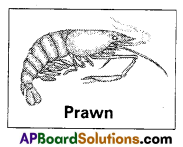
![]()
Question 14.
Compare and contrast cartilaginous and bony fishes.
Answer:
| Cartilaginous fishes | Bony fishes |
| 1. These are marine farms. | 1. These are live in all kinds of aquatic habitats. |
| 2. Endoskeleton made by cartilaginous. | 2. Endoskeleton made by bone. |
| 3. Body covered by placoid scales. | 3. Body covered by cosmoid, ganoid, cycloid or ctenoid scales. |
| 4. Caudal fin is heterocercal. | 4. Caudal fin is homocercal. |
| 5. Operculum absent. | 5. Operculum present. |
| 6. Air bladder absent. | 6. Air bladder present. |
| 7. Gills are lamelliform and are five to seven in each four in each side. | 7. Gills are filamentous and are side. |
| 8. These are ureotelic. Ex: Scoliodori, Pristic, Torpedo |
8. These are mostly ammono telic. Ex: Catla, Labeo, Exocetus, Hippocarnpus. |
Question 15.
Describe the process of transverse binary fission in paramecium.
Answer:
Transverse binary fission is performed by Paramecium. Binary fission is the most common method of a sexual reproduction in protozoans.
During favourable conditions, Paramecium stops feeding after attaining its maximum growth. At first, the micronucleus divides by mitosis and the macronucleus divides into two daughter nuclei by arnitosis. The oral groove disappears. After karyokinesis, a transverse constriction appears in the middle of the body, which deepens and divides the parent cell into two daughter individuals, the anterior proter and the posterior opisthe. The proper receives the anterior contractile vacuole, cytopharynx and cytosome from its parent individual.
It develops posterior contractile vacuole and a new oral groove. The opisthe receives the çosterior contractile vacuole of its parent individual. It develops posterior contractile vacuole and a new oral groove. The opisthe receives the posterior contractile vacuole of its parent. It develops a new anterior contractile vacuole, cytopharynx, cytostome and a new oral groove.
Binary fission is completed in almost two hours, in favourable conditions and Paramecium can produce four generations of daughter individuals by binary fission in a day.
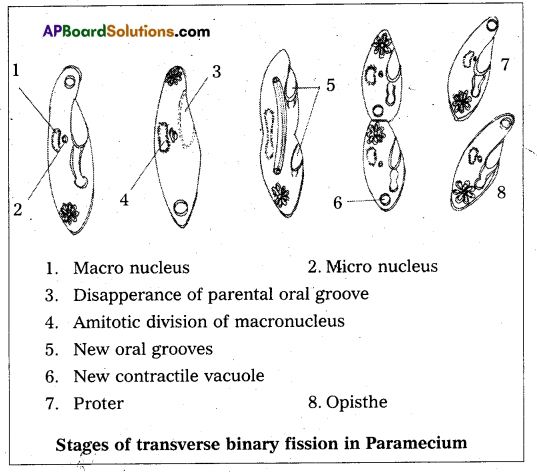
The transverse binary fission is also called homothetogenic fission because the plane of fission is at right angles to the longitudinal axis of the body. As it occurs at right angles to the kineties, it is also called perinatal fission.
Question 16.
What is the need for parasites to develop special adaptations developed by the parasites?
Answer:
Parasites have to evolve mechanisms to counteract and neutralize the host’s defence in order to be successful with in the host. For this purpose, the parasites have developed many special adaptations such as the loss of unnecessary sensory organs, formation of organs for adhesion, high reproductive capacity; etc.
Parasitic adaptations: Parasites have evolved special adaptations to meet the requirements and lead a successful life in the hosts.
- In order to live in the host some parasites have developed structures like hooks, suckers, rostellum etc., for anchoring. e.g: Taenia solium.
- Some intestinal parasites have developed protective cuticles to withstand the action of the digestive enzymes of the host. e.g : Ascaris lumbricoides.
- Some intestinal parasites produce antienzyme to neutralize the effect of host’s digestive enzymes. e.g: Taenia solium.
- Some parasites live as obligatory anaerobes as the availability of oxygen is very rare for them, e.g.: Entarnoebu histological, Taenia solium etc.
- Some intestinal parasites live as facultative anaerobes. i.e., if oxygen is not available, they live anaerobically and if oxygen is available, they respire aerobically. e.g: Ascaris lurnbricoides.
Question 17.
Draw a neat labelled diagram of the mouthparts of Cock roach.
Answer:
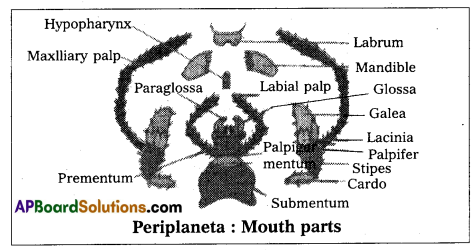
![]()
Question 18.
Describe ‘Green house effect.
Answer:
The term Greenhouse effect has been derived from a phenomenon that occurs in a greenhouse. Greenhouse is a small glass house and is used for growing plants especially during winter. In a greenhouse, the glass panel allows the passage of light into it, but does not allow heat to escape (as it is reflected back). Therefore, the greenhouse warms up, very much like inside a car that has been parked in the sun for a few hours.
The greenhouse effect is a naturally occurring phenomenon that is responsible for heating of the Earth’s surface and atmosphere. It would be surprising to know that without greenhouse effect the average temperature of the Earth’s surface would have been a chilly 18°C rather than the present average of 15°C.
When sunlight reaches the outermost layer of the atmosphere, clouds and gases reflect about one-fourth of the incoming solar radiation and absorb some of it. Almost half of the incoming solar radiation falls on the Earth’s surface and heats it up. While a small proportion is reflected back.
Section – C
2 x 8 = 16
Note: Answer any two questions in 60 lines each:
Question 19.
Describe the structure and life cycle of Ascaris lumbricoides with the help of a neat and labelled diagram.
Answer:
Ascaris lumbricoids is commonly called the common roundworm. It lives in the small intestine of man, more frequently in children. It is cosmopolitan in distribution. Mode of infection is through contaminated food and water. Infective stage is the embryonated egg with the 2 stage rhabditi form larva.
Structure: Sexes are separate and the sexual dimorphism is distinct. In both males and females. The body is elongated and cylindrical. Mouth is present at the extreme anterior end and is surrounded by three chitinous lips close to the mouth mid-ventrally there is a small aperture called excretory pore.
Male: It has a curved posterior end which is considered the tail. The posterior end possesses a cloacal aperture and a pair of equal-sized chitinoùs pineal spicules or pineal setae which serve to transfer the sperms during copulation.
Female: It has a straight posterior end the tail. The female genital pore or vulva is present mid-ventrally at about one third the length from mouth. The anus is present a little in front of the tail end.
Life history: Copulation takes place in the small intestine of man. After copulation, the female releases approximately two lakh eggs per day. Each egg is surrounded by a protein coat with rippled surface. Hence the eggs of Ascaris are described as mammillated eggs. The protein coat is followed by a chitinous shell and a lipid layer internally. These eggs come out along with faecal matter. In the moist soil, development takes place inside the egg so that the 1 stage rhabditi form larva is produced. It undergoes the 1 moulting and becomes the 2nd” stage rhabditi form larva which is considered the stage infective to man. They reach the alimentary canal of man through contaminated food and water.

In the small intestine, the shell gets dissolved so that the 2-stage larva is released. Now it undergoes extra intestinal migration. First it reaches the liver through the hepatic portal vein. From there it reaches the heart through the post caval vein. It goes to the lungs through the pulmonary arteries. In the alveoli of lungs, it undergoes the 2nd moulting to produce the 3rd’ stage larva.
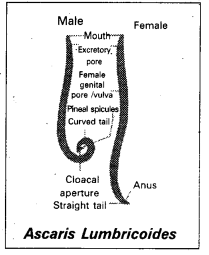
It undergoes the 3 moulting so that the 4th stage larva is produced in the alveoli only. It leaves the alveoli and reaches the small intestine again through the bronchi, trachea, larynx, glottis, pharynx, oesophagus and stomach. In the small intestine. It undergoes the 4th and final moulting to become a young one which attains sexual maturity within 8 to 10 weeks.
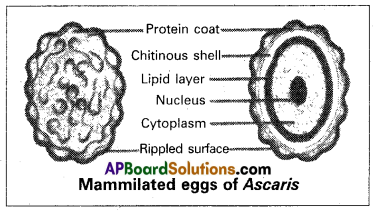
Question 20.
Describe the blood circulatory system of Periplaneta in detail and draw a neat and labelled diagram of it.
Answer:
The circulatory system helps in the transportation of digested food, hormones etc., from one part to another in the body. Periplaneta has an open type of circulatory system as the blood or haemolymph, flows freely within the body cavity or haemocoel. Blood vessels are poorly developed and open into spaces. Visceral organs located in the haemocoel are bathed in the blood. The three main parts associated with the blood circulatory system of Periplaneta are the haemocoel, heart and blood.
Haemocoel: The haemocoel of cockroaches is divided into three sinuses by two muscular, horizontal membranes called dorsal diaphragm or pericardial septum and ventral diaphragm. Both the diaphragms have pores. There is a series of paired triangular muscles called alary muscles. Every segment has one pair of these muscles situated on the lateral sides of the body. These are attached to the pericardial septum by their broad bases and to the terga by their broad bases and to the terga by their pointed ends or apices.
The three sinuses of the haemocoel are known as pericardial haemocoel or the dorsal sinus, the perivisceral haemocoel or the middle sinus and sternal haemocoel or ventral sinus or perineural sinus. The middle sinus is very large as it contains most of the viscera. The dorsal and ventral sinusecs are small as they have only heart and nerve cord, respectively.
Heart: The heart lies in the pericardial haemocoel or dorsal sinus. It is a long muscular, contractile tube found a long the middorsal line, beneath the terga of the thorax and abdomen.

It consists of 13 chambers. Every chamber opens into the other present in front of it. Three of the thirteen chambers are situated in the thorax and ten in the abdomen. Its posterior end is closed while the anterior end is continued forward as the anterior aorta.
At the posterior side of each chamber, except the last, there is a pair of small apertures called ‘Ostia’ one on each side. Ostia have valves which allow the blood to pass only into the heart from the dorsal sinus.
Blood: The blood of Periplaneta is colourless and is called haemolymph. It consists of a fluid called plasma and free blood corpuscles or haemocytes, which are phagocytic. The phagocytic, the phagocytes are large in size and can ‘ingest foreign particles such as bacteria. There is no respiratory pigment in the blood and so it plays no major role in respiration.
![]()
Question 21.
Describe different types of food chains that exist in an ecosystem.
Answer:
The food energy passes from one trophic level to another trophic level mostly from the lower to higher trophic levels. When the path of food energy is ‘linear’ the components resemble the links of a chain and it is called ‘food chain. Generally, a food chain ends with decomposers. The three major types of food chains in an ecosystem are Grazing Food Chain, Parasitic Food Chain and Detritus Food Chain.
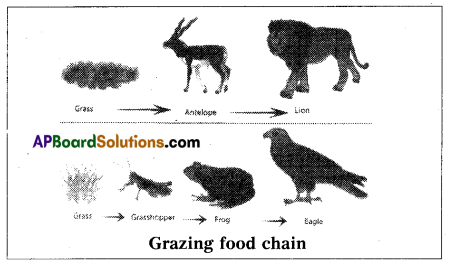
i) Grazing food chain: It is also known as predatory food chain, it begins with the green plants (producers) and the second third and fourth trophic levels are occupied by the herbivores, primary carnivores and secondary carnivores respectively. In some food chains these is yet another trophic level the climax carnivores.
The number of trophic levels in food chains varies from 3 to 5 generally. Some examples from grazing food chain (GFC) are given below.

ii) Parasitic food chain: Some authors included the Parasitic Food Chains as a part of the GFC. As in the case of GFCs, it also begins with the producers, the plants (directly or indirectly). However, the food energy passes from large organisms to small organisms in the parasitic chains. For instance, a tree which occupies the si trophic level provides shelter and food for many birds. These birds host many ectoparasites and endoparasites. Thus, unlike in the predator food chain, the path of the flow of energy includes fewer, large-sized organisms in the lower trophic levels and numerous, small-sized organisms in the successive higher trophic levels.
iii) Detritus Food Chain: The detritus food chain (DFC) begins with dead organic matter (such as leaf litter, bodies of dead organisms). It is made up of decomposers which are heterotrophic organisms, mainly the fungi and bacteria. They meet their energy and nutrient requirements by degrading dead organic matter or detritus. These are also known as saprotrophs (sapro: to decompose).
Decomposers: Secrete digestive enzymes that break down dead and waste materials (such as faeces) into simple absorbable substances. Some examples of detritus food chains are:
- Detritus (formed from leaf litter)-Earthworms – Frogs – Snakes.
- Dead animals – Flies and maggots – Frogs – Snakes.
In an aquatic ecosystem, GFC is the major conduit’ for the energy flow. As against this in a terrestrial ecosystem, a much larger fraction of energy flows through the detritus food chain than through the GFC. The Detritus food chain may be connected with the grazing food chain at some levels. Some of the organisms of DFC may form the prey of the GFC animals. For example, in the detritus food chain given above, the earthworms of the DFC may become the food of the birds of the GFC. It is to be understood that food chains are not ‘isolated always.